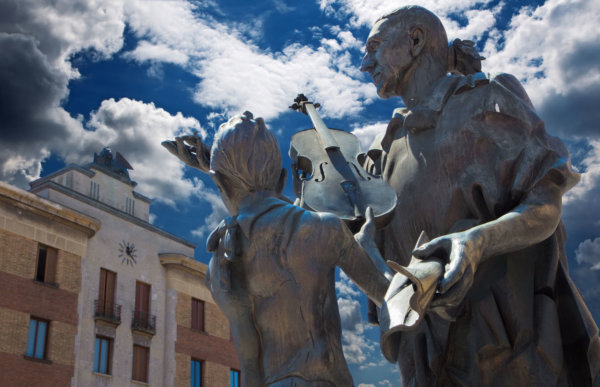In Cremona, searching for the face of the most famous luthier ever.
Antonio Stradivari: the name of the most famous luthier of all time resounds in every corner of the planet but many events of his existence remain shrouded in mystery. One above all is his face.
What did Stradivari look like?
Various pictures circulate on books and on the web showing the alleged features of the craftsman who lived in Cremona between the 17th and 18th centuries, creating the most extraordinary violins that ever existed.
The best known of all, reproduced on engravings, posters, postcards, books and even stamps, is a Parisian print by Adolphe Muilleron (1820-1881) derived from a portrait of the Belgian Edouard Jean Conrad Hamman (1819-1888). It is the romantic image of a noble and wise Stradivarius observing a violin. But it’s totally imaginative. The original painting is currently unavailable and may be lost forever.

At the Museo del Violino (Violin Museum) in Cremona, however, we can now admire two representations of the master ‘in flesh and blood’.
The first, entitled La bottega di Stradivari (“Stradivari’s workshop”), is a canvas by Alessandro Rinaldi from Cremona dating back to 1886, presented at the Società Permanente of Milan. The other (on exhibit for the first time!), is an alleged Portrait of Stradivari attributed to Bernardino De Hò, a Cremonese painter active in Stradivarius’ age and known for an eccentric and ironic style.
These two paintings could not be more dissimilar in age, size, support, origin and “mood”. The style of each reflects the spirit of the time in which they were painted: a lanky craftsman staring at his varnish as an alchemist, mixing late Romanticism and Social Realism, versus a ruddy and grotesque over-sized little man painted by an artist who, almost two centuries before, had a lot of fun kidding the pompous Baroque with a caricatural everyday-life painting.
But there is more to say. Among misunderstandings, other lost works known only through publications, and real fakes coming up regularly and statues scattered around Cremona it is difficult to find out the truth. There is also a large canvas by Angelo Massarotti (1654-1723) in the Cremonese church of Sant’Agostino, with an alleged portrait of Stradivari among a crowd of people, which has nothing to do with him, depicting an episode of the Augustinian Order’s history!
How can you pick up the threads of an unsolved mystery?
By visiting Cremona with a CrArT tour guide. In search of Stradivari, at the Museo del Violino and along the streets of the city, among churches, squares and gardens.





